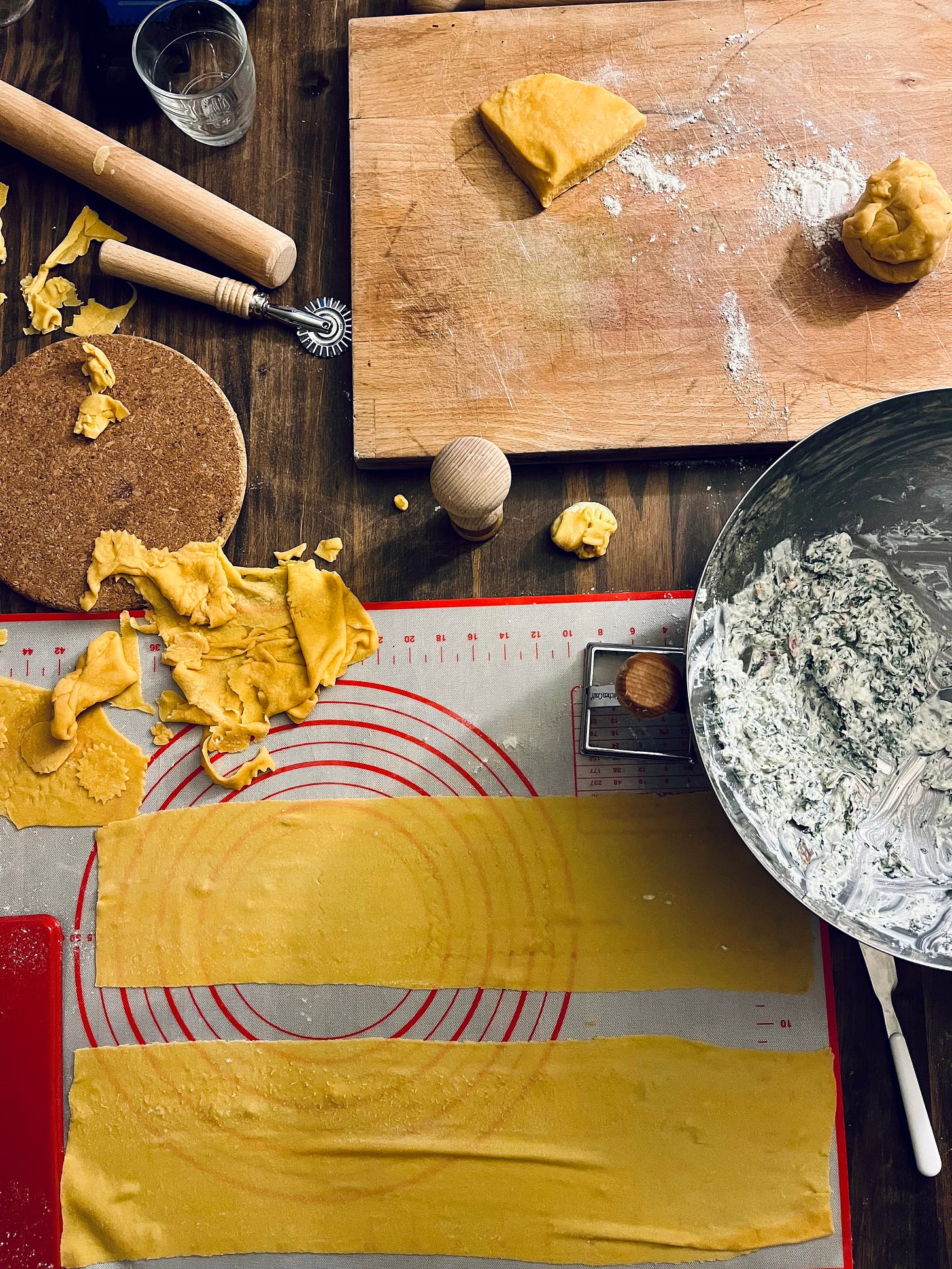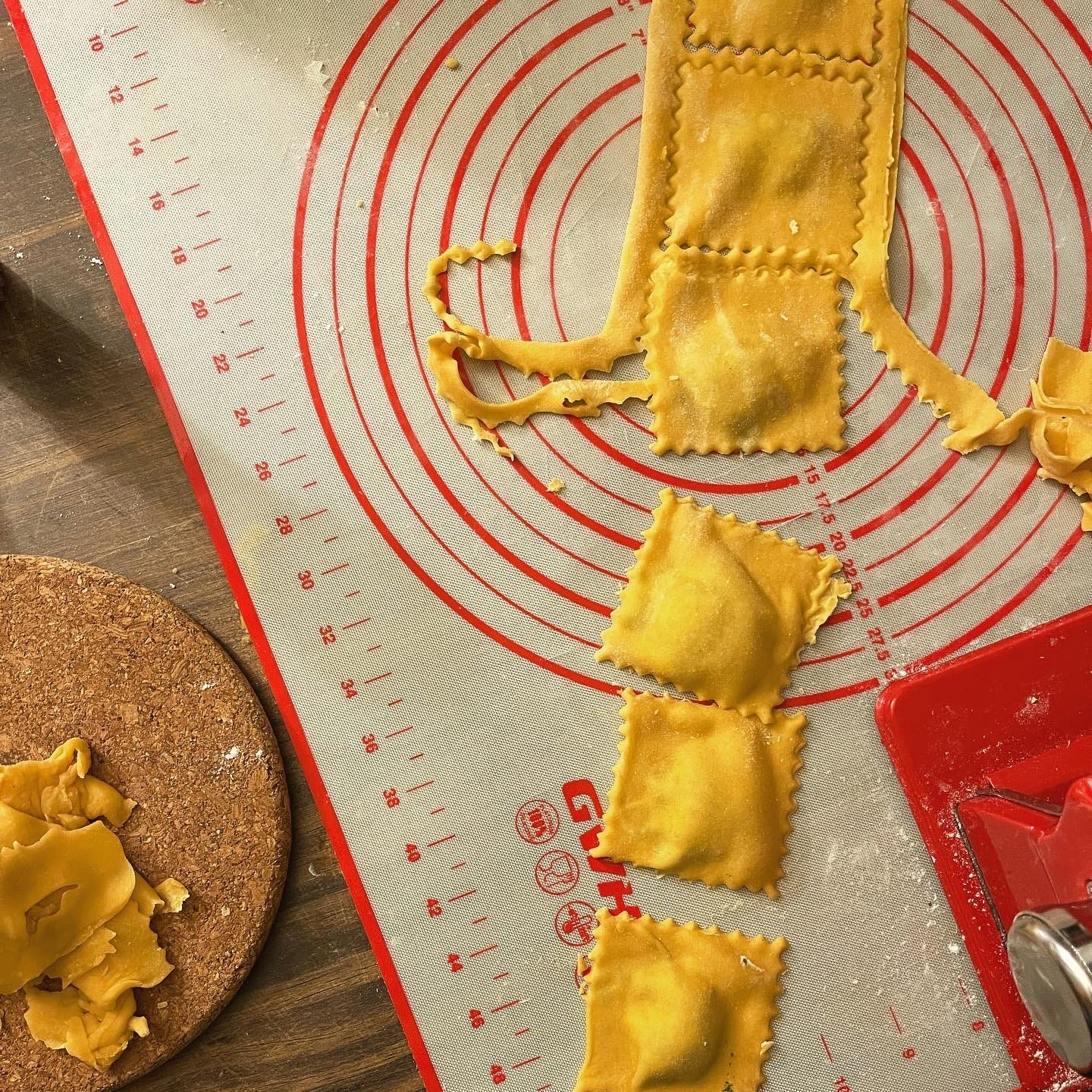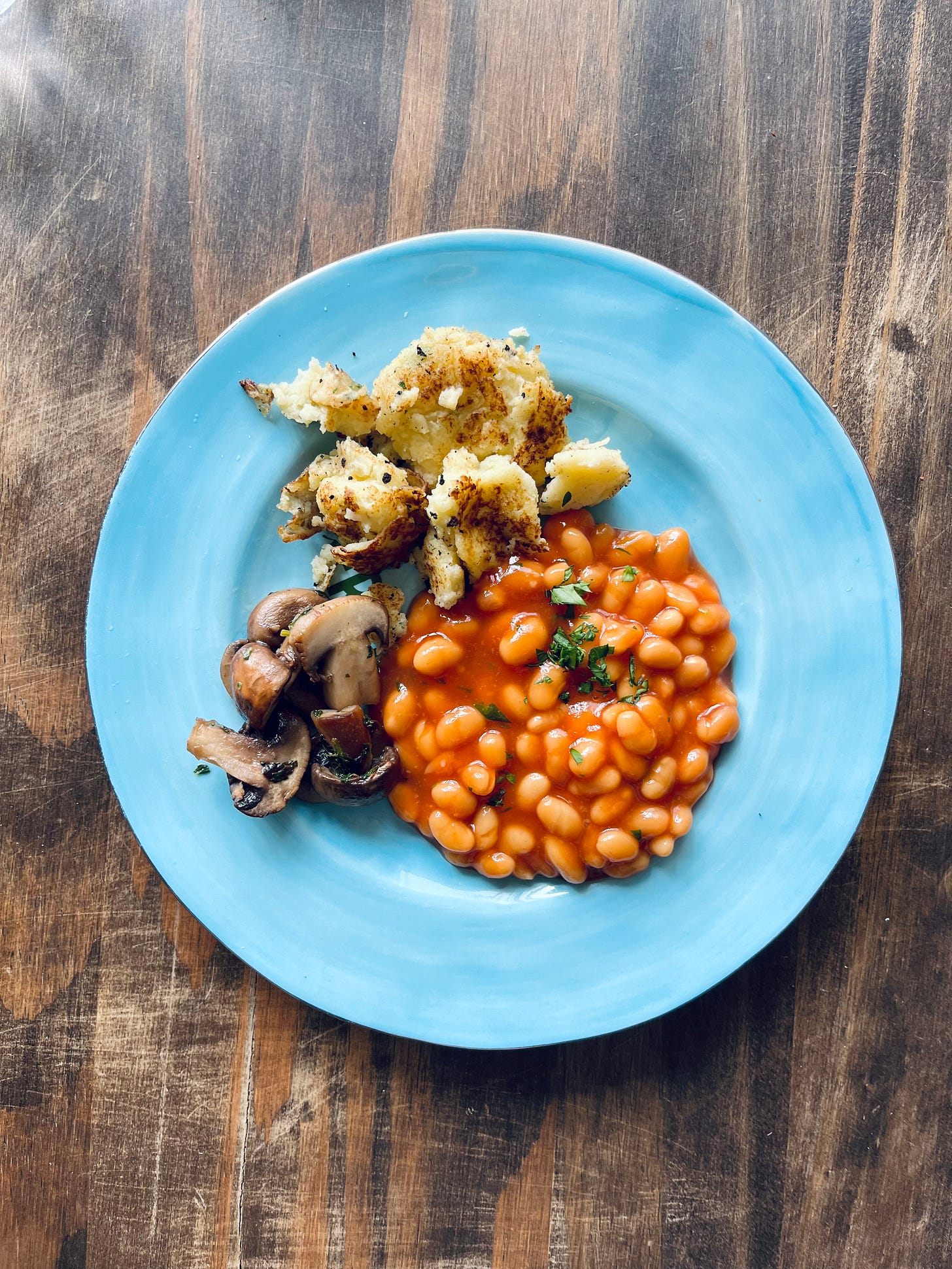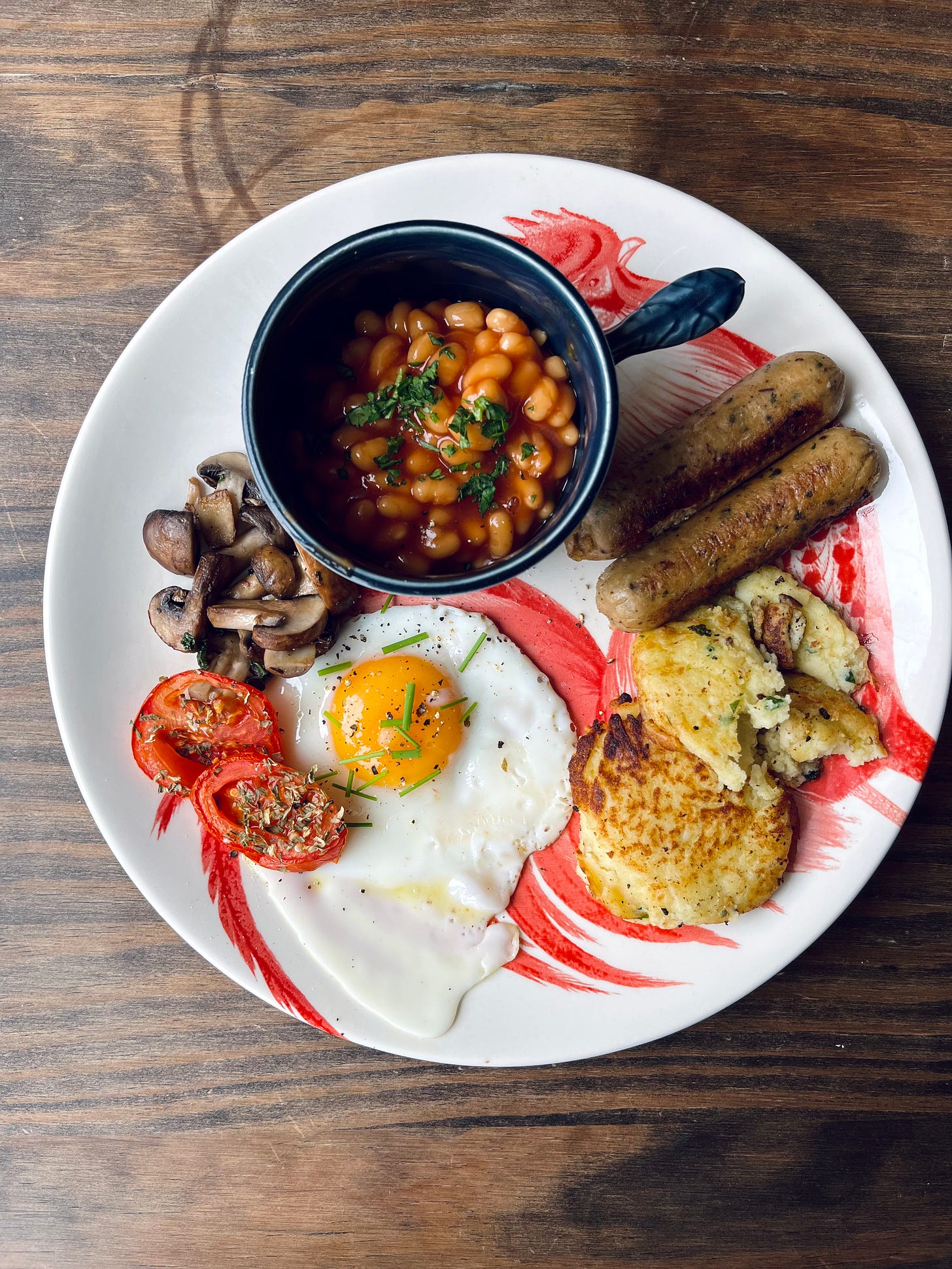Cooking with Louise: On Delaying
temporalization and taste; making ravioli and cooking a version of the full English breakfast
Louise has responded ‘why?’ to pretty much everything I have told her so far, even when I was responding to her asking me why. She loves prunes and bananas and peppers. She hates her food being warm and still can’t believe that the sticky notes on my desk are made of elephant poop. Truth be told, she finds it hilarious. She wants to go higher with the swing and to build sandcastles. Louise is my three-year-old niece who came to stay at my flat for the first time during the bank holiday, and before knowing her, I had never spent much time with a child.
Nor had I cooked with one.
In the last two editions of The Onion Papers, I wrote about losing my taste for cooking and finding it again while talking with friends and realising that a recipe is a composition. I had always thought of myself as an intuitive cook and eater until I flawed my appetite by relying on my tastebuds solely. I was trapped inside the patterns of a solo meal – and it turns out, cooking with Louise has been a great school to see me through that. With Louise next to me in the kitchen, I had to approach decisions as a negotiation. Close your eyes and think of her looking at me with inquisitive eyes – ‘tatie, pourquoi tu fais ça ?’ – and hear Louise ask me why I do such things as I do them. Cooking with Louise meant delaying my reflexes.
Louise likes doing things for herself. Together we made ravioli filled with ricotta, chard and lemon zest, which we served with a sage and butter coating. It took some time to make, so let’s start with the dough:
00 flour
semola
eggs
When making dough, I’d always suggest adjusting measures as you go. If you’re also cooking with a child, you’ll want to have some spare dough (more on that below, for now be generous with measurements). Throw some flour and semola (you’re looking at a rough 60/40 share between the two) in a large working bowl or surface, make a volcano, and crack two eggs in the middle. Work the dough with your hands, adding eggs and/or flour as you go, until the dough forms a homogeneous, non-sticky ball. Put it away in the fridge for 30 minutes.
Keep the white of one of your eggs aside for later.
pause, delay —
‘Salt, Fat, Acid, and Heat were the four elements that guided basic decision making in every single dish, no matter what. The rest was just a combination of cultural, seasonal, or technical details, for which we could consult cookbooks and experts, histories, and maps. It was a revelation.’ – introduction to Salt, Fat, Acid, Heat by Samin Nosrat
While spending time with Louise, I re-learnt first-hand that many feelings are immediate. Joy, curiosity, tiredness, or hunger ground the present into something relatable, felt between us; the source elements of cooking like salt, fat, acid and heat, as I had learnt before by reading Samin Nosrat’s eponymous cookbook, build the foundations for a good dish. They are chemicals, but they aren’t whole on their own either. They must interact against and/or with something else.
Louise asked why, again, and I thought about what to say. I also noticed that Louise’s attention span is linked with how busy her hands are, just like her aunt. While the pasta dough rests in the fridge, prepare the filling:
ricotta
egg white (leftover from making the pasta dough)
chard, pan-fried and cooled
lemon zest
In a large bowl, mix all the ingredients together. You can add a pinch of flour if the preparation is watery. Set aside in the fridge.
Time to shape the ravioli: divide the ball into smaller bits. Louise and I each had our share of the dough to work on. Flatten each ball with a rolling pin and start passing the pasta sheets through the pasta machine. We pushed ours all the way to 3; semola makes for robust doughs.
Lay out each pasta sheet (it should be long and wide enough to be folded in two), and spoon drops of filling towards the bottom of the sheet. Fold the dough over the filling, seal it together with the tip of your fingers, and cut the ravioli. If you have a ravioli stamp maker, it’s time to use it. Otherwise, you can cut them with a knife, or I found that a small, squared Tupperware works wonders. What matters for the process to go (fairly) well, is to have a measurement reference – you need to know how to space the filling.
With my niece, I put London in perspective. We were spoiled with a sunny weekend, and we walked along the docks, the canals, and the river Thames. We painted protest signs on the ground floor at the Tate and we visited the community-run Mudchute farm. We queued because London can never resist a waiting line – this much baffled Louise. We ate an ice-cream.
I looked at Louise running towards a group of children shortly after we arrived at the playground in Victoria Park. She fitted in and she started working in a chain with other kids to lift sand all the way to the top of the slide. The age gap between the children felt wide to me; Louise doesn’t speak English. Still, the process was an elaborate choreography between gestures, spoken words, pauses and watchful eyes – there, as it happened, meaning was being threaded between them.
delay – a truth is never fully present:
‘That is what deconstruction is made of: not the mixture but the tension between memory, fidelity, the preservation of something that has been given to us, and, at the same time, heterogeneity, something absolutely new, and a break.’ – Jacques Derrida, from Deconstruction in a Nutshell: A Conversation with Jacques Derrida
Philosopher Jacques Derrida is most famous for his theory of deconstruction, as well as his tweak on the spelling of the French word ‘différence’. It became ‘différance’, written with -a instead of -e, a concept that links two meanings in one word: to differ and to defer.
I’m interested in the latter to consider the notion of temporalization as a show that meaning is unstable. I’m making a shameless digression to quote Derrida, admittedly out of his usual context, because I want to say that no idea nor emotion is static, ever, and I worry you might not care enough about my pasta. A part of me doesn’t want you to see me with my apron on when I do, yet I want to say that sometimes I’m finding that life goes too fast — time, growing up, losing touch and reconciling — and sometimes the pace isn’t fast enough, but that intervals exist.
knead a dough; proof; work the dough
I don’t want to reduce speaking about temporalization in the kitchen to getting your timings right either (I’m no-one to tell you if you should cook your pasta for 3 or 5 minutes!), but as an aggregation of factors that make a meal. I’m thinking about the differences that compose a truth; that present is deferred because the present is plural in its experience. There are the basic elements of cooking, returning to Samin Norsat: salt amplifies flavours, fat contributes to flavours, acid enhances flavours and heat is the conductor that transforms elements into flavours; then there are the différances: us, cooks and eaters, interacting beings. Delaying is necessary to acknowledge the disconnections between the enablers (salt, fat, acid, heat) and one’s intuitions and perceptions (a present individuality). And that what speaks greater meaning is the moving tension between these withholding and separating forces. That one should have agency over the latter, to differ and defer.
Temporalization accommodates being within existing; in delaying, one can break and reassess meaning.
delay, defer, water boils –
ravioli
butter
sage
Bring a large pot of water to the boil and cook the ravioli. In the meantime, melt butter and sage in a large pan. Keep the heat low so the butter doesn’t cook, you want the dairy to conserve a velvety texture. Once the ravioli are cooked, transfer them into the pan and crisp them in a coat of butter. Serve with a sprinkle of black pepper and Parmesan cheese on top, if you’d like.
The next morning, Louise asked me if we could make pasta again for dinner. I answered that we’d think about that later, and of course she asked why. I can’t remember what I said exactly, but I imagine that I suggested we postpone the decision because we didn’t know what we’d fancy that night yet.
delaying –
so we could tackle breakfast in the meantime.
This time, it was a pragmatic exercise of temporalization in the kitchen as we accommodated dietary requirements and cooked a full English breakfast over one working surface. Louise asked why I did things this way at each step.
Our recipe might not suit the meaning of the word traditional, but since we were in our kitchen and truth doesn’t have to be either/or, we composed ours like that:
- canned baked beans in tomato sauce, heated in a pot
- chestnut mushrooms, roughly chopped and lightly pan fried
- tomatoes, sliced and baked in the oven with a sprinkle of dried basil and salt
- egg, pan fried
- vegetarian sausages, pan fried
- hash browns made with boiled potatoes, mashed and mixed with salt, parsley, one egg and flour; cooked with oil in a pan
Time loops, slips away; I worry. Time heals, stitches; time passes. The minutes grow older, I delay.
Margaux
PS. Wishing you all a good weekend. If you’re based in the UK and looking for a distraction, might I suggest hanging out in The Yellow Kitchen, my debut novel? I promise my girls are much more into candies and Marie-Antoinette than the other lot. You can find the paperback edition in your favourite bookshop, or on the Onion Papers affiliated shop.
Thanks for being here! This newsletter comes out every other Thursday (Friday? Saturday?), and you can fuel it by subscribing below or forwarding it to a friend.









